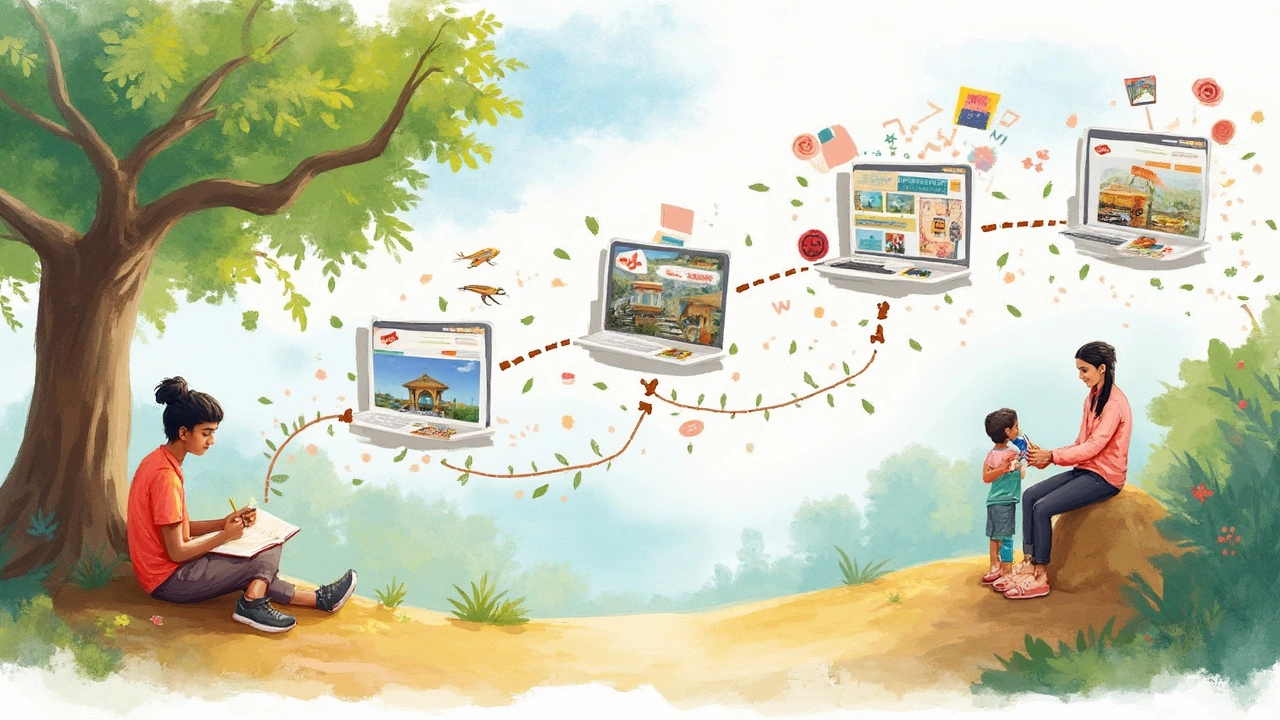People think building a website is hard or always expensive. That’s just not true anymore. With free website builders, pretty much anyone can stick their name online in minutes—sometimes without touching any code. You don’t need to be a developer or have stacks of cash to spare.
Most of these platforms are designed for regular folks, not just tech pros. They come with ready-made templates, drag-and-drop tools, and step-by-step wizards. If you know how to set up a social media profile, you’ve got enough skills to make your own website.
But here's the trick: "free" has some fine print. Nothing is totally without trade-offs. Want your own custom address, like yourownsite.com? Most free builders won’t give you that unless you pay. Need unlimited storage or want to sell stuff online? There are some catches there, too. Still, if what you need is a simple blog, a personal portfolio, or even a homepage for a side hustle, you can definitely start for zero dollars.
- What Does 'Free' Actually Mean?
- Getting Started: How Easy Is It Really?
- Biggest Limitations of Free Website Builders
- Tips for Making the Most Out of Free Platforms
- When and Why You Might Pay Later
What Does 'Free' Actually Mean?
When you see a website builder calling itself free, it usually means you can launch a basic website without spending any cash. But there’s a catch: what you actually get for free is almost always a stripped-down version of the real thing. The basics are free—anything fancy costs extra.
Take Wix, for example. They let you build and publish a site for zero dollars, but your website address will be something like yourname.wixsite.com. Want your own domain, like mycoolsite.com? That's going to cost you. Same idea with platforms like Weebly, WordPress.com, and Google Sites. You get easy drag-and-drop editors, a handful of themes, and some limited storage or bandwidth. But your free website builder plan will have things like:
- Platform branding, where their logo shows up in your site's footer or header.
- Ads you can’t control (on your own website!).
- Limited features—like only a few contact form fields, or no way to accept payments.
- A subdomain that looks less professional than a custom domain.
What’s totally free is the stuff that gets you started and lets you try things out. Once you want those pro extras—more templates, e-commerce, custom email, or removing branding—you’ll hit a paywall. A free plan is mainly for basic needs or testing ideas before you go all in. Don't expect champagne on a tap-water budget. But you can definitely get online and play around before thinking about upgrades.
Getting Started: How Easy Is It Really?
Signing up for a free website builder takes less time than ordering a coffee. Most of them—like Wix, Weebly, and Google Sites—just ask for your email and a password. After you’re in, you’ll see a dashboard with clear instructions. You won’t face code unless you want to, and the layout is usually super simple.
To give you a real idea, here’s what the process usually looks like:
- Sign up with your email or social account.
- Pick a template—these are pre-designed pages you can tweak.
- Edit your content by swapping text and images directly on the page.
- Click "publish." That’s it. Your site goes live instantly.
If you’re worried about options, check this out. Some builders even walk you through an onboarding quiz to pick your site’s style or purpose and suggest layouts automatically. It’s like a website-creation autopilot. Wix ADI (Artificial Design Intelligence), for example, asks a few questions then cooks up a whole site just for you, ready in minutes.
Want some hard numbers? A 2024 test across popular platforms found:
| Builder | Sign-up to Publish Time | Code Needed? |
|---|---|---|
| Wix | 12 minutes | No |
| Weebly | 10 minutes | No |
| Google Sites | 7 minutes | No |
| WordPress.com | 16 minutes | Optional |
So, the learning curve is close to zero. If you’ve ever made a Facebook post or dragged files on your desktop, you’ve got the skills for this.
One quick tip: Play around with templates before you commit. Most builders let you preview how things look on mobile and desktop, so you’re not stuck with a style you hate.
You don’t need to install anything, and updates or security? The builder handles it automatically. Can it get any easier?

Biggest Limitations of Free Website Builders
There’s no such thing as a totally free lunch, and free website builders are a perfect example. While you get a lot for nothing, you also run into limits that can get annoying once you want your site to look more professional or do more. Let’s break down where free really means “not everything.”
The first thing that stands out: you won’t get your own web address. Instead, your site gets stuck on something like yourname.buildername.com. It looks less professional, especially if you’re hoping folks remember your URL or you plan to advertise your site.
Most free website builder options also put their own ads or branding on your pages. So, visitors will see "Powered by Wix" or "Made with Weebly" banners, which can feel tacky if you’re aiming for a clean look. There’s no way to turn off these ads unless you start paying.
Customization is another spot where free plans fall short. You usually get basic templates and can’t mess much with design, fonts, or fancy features. Want to change colors or move stuff around? Sometimes, you can only do the basics. Forget about adding custom code—most free builders just don’t allow it.
If you’re thinking about starting a shop, free builders are tough on e-commerce. Some won’t let you sell at all, and others put big restrictions on what or how much you can offer. Features like inventory management or customer tracking are often completely off-limits unless you upgrade.
Check out how the big names stack up on the most common free plan limits:
| Platform | Custom Domain | Ads/Branding | Storage | Can Sell Online? |
|---|---|---|---|---|
| Wix | No | Yes | 500 MB | Only with paid |
| Weebly | No | Yes | 500 MB | Yes, limited |
| WordPress.com | No | Yes | 1 GB | Not on free plan |
| Google Sites | No | No | Unlimited (uses Google Drive) | No |
There’s also the issue of limited support. On free plans, if you get stuck, you’re usually digging through help articles or asking in public forums. Fast, one-on-one help is saved for paying users.
And finally, performance and SEO tools are basic. Many free builders don’t let you see traffic stats or tweak much for Google rankings. If getting found online matters to you, these limits become obvious fast.
Tips for Making the Most Out of Free Platforms
Free website builders have a lot to offer, but you’ll get way more out of them if you play smart. It's not just about picking the platform—it’s about squeezing every bit of value from what they give you. Here’s how to do that, with practical tips you can use right away.
- Pick the right builder for your actual needs. For a blog, Wix and WordPress.com are hard to beat. Want to showcase photos or art? Check out Wix or Weebly. If you dream of a simple online store, Square Online gives you a basic shop for free (just expect their transaction fees).
- Be strategic with templates. Don’t just settle for the first design you see. Look for templates that fit the vibe you want, and stick with ones that are easy to customize. Less tweaking means less hassle and better results.
- Fill your site with useful, original content. Search engines like Google put well-written, helpful pages higher in results. Make sure your pages answer real questions or show off what you do best.
- Keep navigation dead simple. Free platforms can get messy if you add too many pages. Stick to 4 or 5 main links—think Home, About, Contact, Blog/Portfolio, Services/Shop. Make it easy for people to get around.
- Use built-in SEO tools. Most free builders now come with basic SEO helpers. Tweak your page titles and descriptions—these make a difference on Google. For example, with Wix, you can change this stuff right from the editor.
Choosing the right free platform actually comes down to a few key features. Here’s a quick table comparing what some top builders offer at no cost as of 2025:
| Platform | Custom Domain? | Free Storage | E-commerce Option? | Ads Shown? |
|---|---|---|---|---|
| Wix | No (.wixsite.com subdomain only) | 500 MB | Limited, basic products | Yes |
| WordPress.com | No (.wordpress.com subdomain only) | 1 GB | No (needs paid plan) | Yes |
| Weebly | No (.weebly.com subdomain only) | 500 MB | Yes, limited | Yes |
| Square Online | No (.square.site subdomain only) | Unlimited | Yes, products only (with transaction fees) | Yes |
You don’t have to worry about technical headaches with these free builders, but always back up your content somewhere in case you ever want to move. And don’t get discouraged by the small “Free Plan” labels or ads—more than 40% of amateur sites stay on free plans for years, and that’s totally normal.
The key takeaway: focus on what free website builder plans do best—quick launches, easy updates, and no upfront cost. Everything else is icing on the cake.

When and Why You Might Pay Later
Most folks hit a wall with their free site sooner or later. The thing is, free builders are designed to get you started, but that's not the whole ride. If your site starts growing, or you need a feature that helps your business stand out, you'll probably have to pull out your wallet.
Here’s when people typically decide to pay:
- Custom Domain: The default website address on free builders usually looks like yourname.platform.com, which doesn’t scream professional. Getting a real domain—like janesbakery.com—almost always requires an upgrade.
- Removing Ads: Free builders make money by slapping their own ads all over your site. Only paid plans ditch these distractions.
- Adding E-commerce Tools: Want to sell a product or take bookings? Payment, inventory, and shopping cart options are usually locked behind a paywall.
- Extra Storage or Bandwidth: Free plans often put a cap on the amount of images, videos, or files you can upload. More visitors? That might cost extra, too.
- Better Customer Support: With free sites, you’ll probably rely on help docs or forums. Paid plans usually unlock live chat or priority email support, which can save hours when things break.
The decision can sneak up on you. Maybe you’re fine at first, but a year later you want email at your domain or you outgrow basic templates. Here’s what you can expect from the biggest platforms:
| Platform | Free Plan Limits | Cheapest Paid Plan (USD/month as of 2025) | Key Paid Features |
|---|---|---|---|
| Wix | Wix branding, no custom domain, limits on storage | $17 | Custom domain, remove ads, increased storage |
| Weebly | Weebly branding, basic layouts, limited analytics | $13 | No ads, domain connection, site stats |
| WordPress.com | WordPress ads, limited plugins/themes | $4 | Custom domain, more design options |
| Squarespace | No free plan (14-day trial only) | $16 | Unlimited pages, full design control |
If you're planning to build a personal blog or portfolio and keep it simple, free might work forever. But if you’re hoping to grow a business or brand, expect to upgrade once you bump into the limits. At that stage, knowing your needs helps avoid surprise costs. Always check the fine print before investing time in a platform.
So, free website builder plans are a great way to dip your toes in, but most users eventually pay to unlock a more useful, polished, or powerful site. Some stick with the basics, but plenty decide it’s worth the upgrade for a site that feels truly their own.
